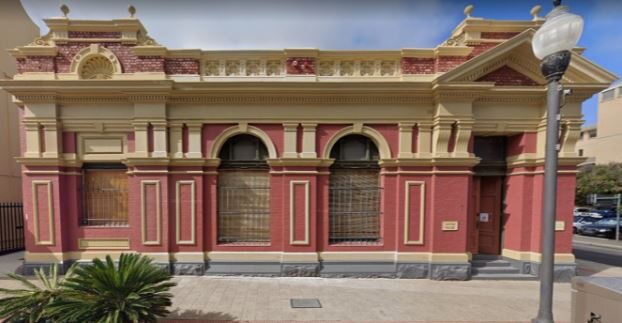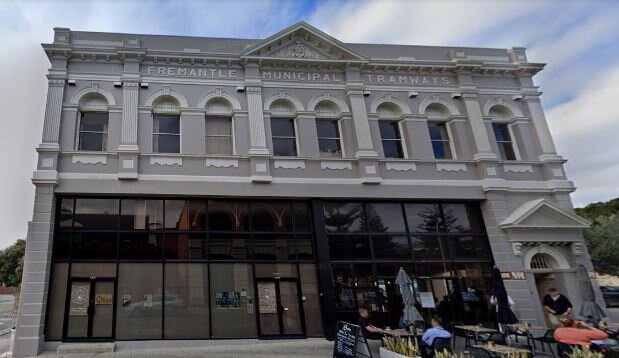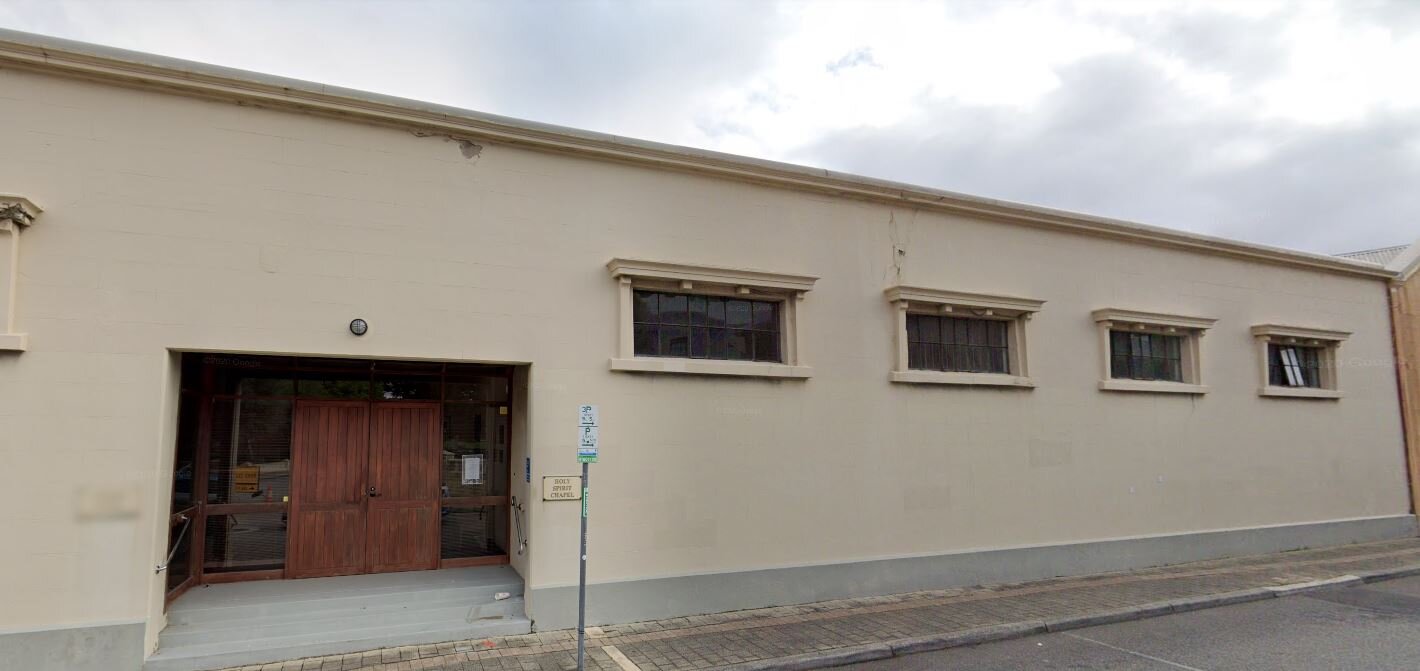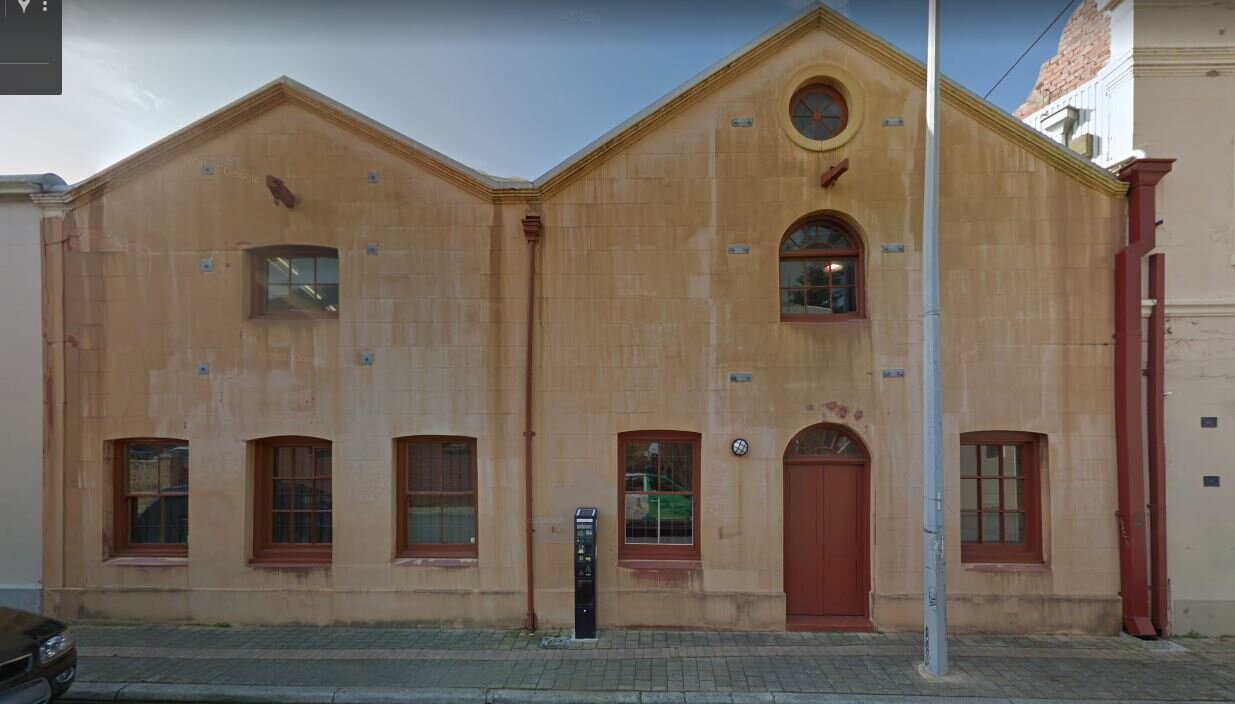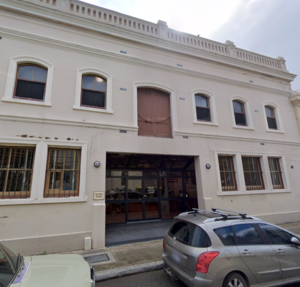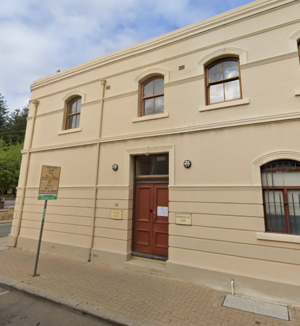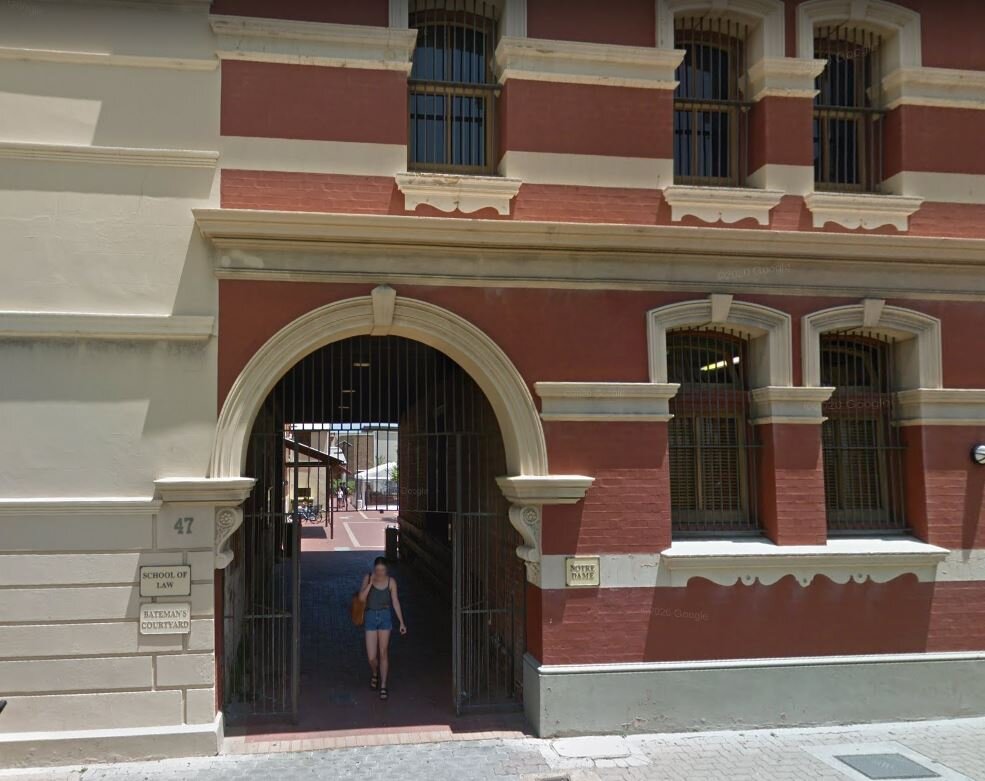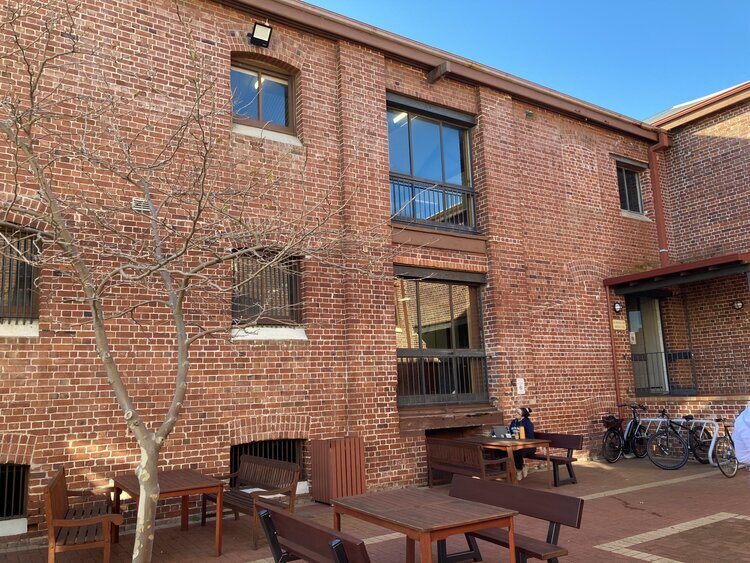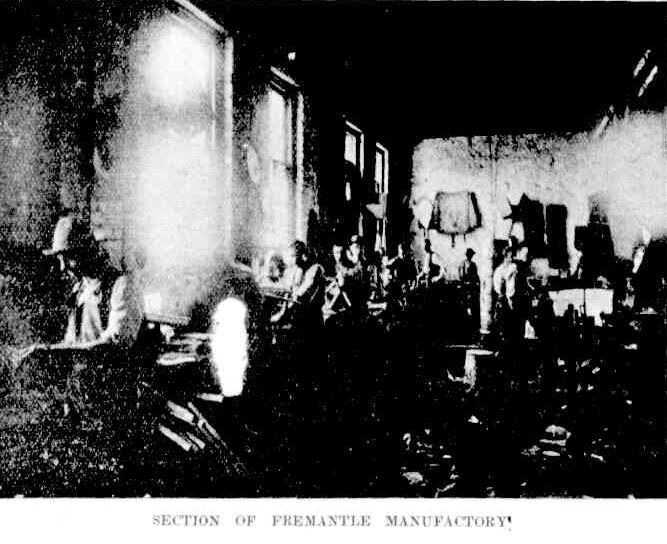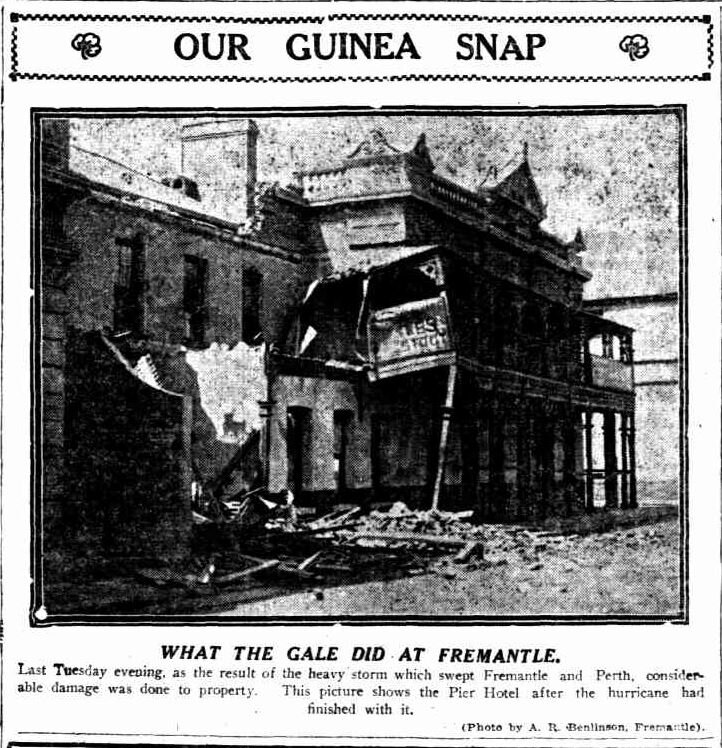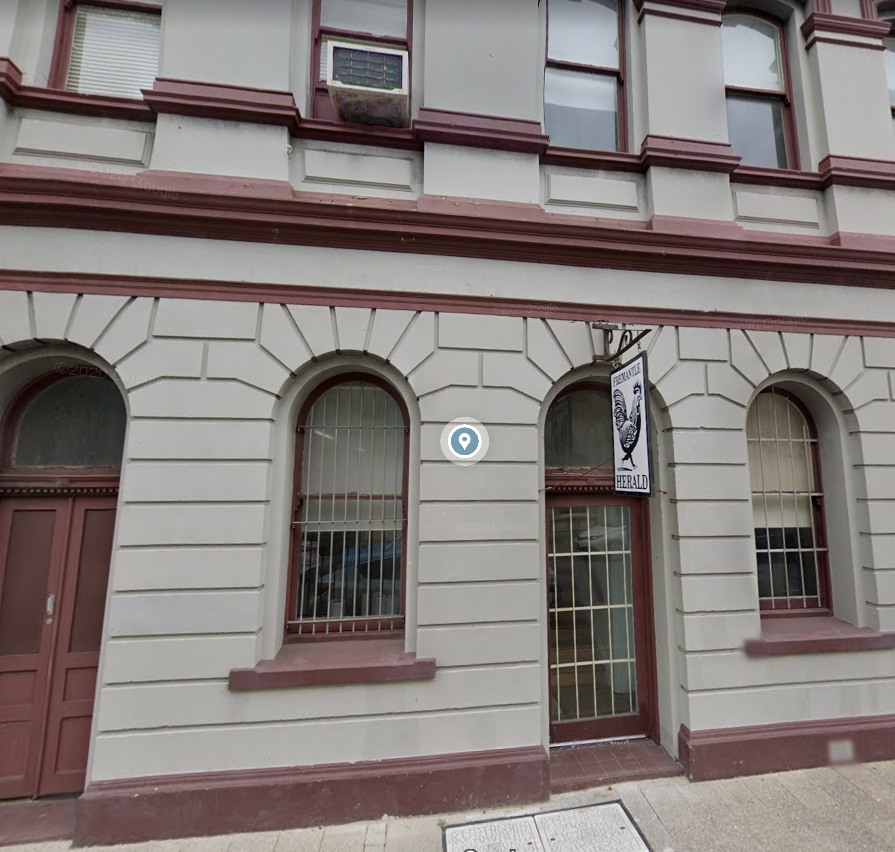Lilly's Building 34-42 Cliff St was designed by architect Herbert Nathaniel Davis and built in 1896.
Architecture Lilly's Buildings is a two storey stone building with rendered façade, bracketed parapet and a zero set back from the pavement. Engaged pilasters (ashlar effect on the ground floor) flank the doors and windows. The timber windows have stucco arches and keystone above transoms, on the ground floor. The first floor has stucco aedicule surrounds (there are alternating triangular and semi circular pediments), above the timber sash windows.
History Lots 23 and 24 were originally owned by W & P Chidlow (1829-1879). There was a stone house on the site as early as 1844. The first Customs House was built on these lots in 1853. A new Custom's House was built in 1903 on Phillimore St, and the old Custom's House became a warehouse (No. 40 Cliff St).
In the 1880s, the site was owned by Capt James Lilly who established a shipping office.
1896 To arrive on or about 31st December, by the Queen Adelaide From KARACHI. 400 EGYPTIAN CAMELS. The finest travellers and weight carried the world. This shipment comprises by far the selection of camels that, so far, have imported to this colony, being short and thick-boned animals, and, specially selected from districts climatic conditions are similar to this colony, will not be aflected by the weather experienced on our Eastern fields during the winter months. The Camels will be on view at the Quarantine Grounds, near Fremantle, during January, and the public are cordily invited to inspect same. JAMES LILLY & CO. (As Agents for Hassa & Mulchand & Co.), Fremantle. (reference)
1898 TRAGEDY AT FREMANTLE. BOY SHOOTS HIMSELF. SENSATIONAL CIRCUMSTANCES. A terrible tragedy occurred at North Fremantle last night, when a boy named Henry Mason, aged 16, a clerk employed by McIlwraith, McEacharn, and Co, shot himself. The deceased was a son of Frederick Mason, an old resident of the colony, and one of the wealthiest men in Fremantle, owning the greater portion of the main street and a large number of other properties. For many years Mr. Mason, sen., has been residing at North Fremantle with a woman who was supposed to be his wife and by whom he had five children, Henry Mason being one of them. Great surprise was caused to friends of the family, and a painful scandal was occasioned, when Mr Mason, about a month ago, married Mrs Hillmer, who had been renting a hotel from him, and when it became known that the woman he had lived with so long was not his wife at all. (reference) (divorce of Mr Mason & Mrs Hillmer 5-years later is reported here)
1902 Amongst the passengers by the steamer Paroo, which arrived at Fremantle from the East yesterday, was Mr. Matvson, of the Melbourne staff of M. Glassford Proprietary. Ltd., who has come to relieve Mr. James Murdoch, the local manager, who is leaving in the G.M.S. Barbarossa on a trip to Scotland. (reference)
1908- UNWHOLESOME FRUIT. SILBERT AND SHARP SUED. At the Perth Police Court yesterday. before Mr. A. S. Roe, P.M., Silbert and Sharp were charged with having, on Dec ceinber 23, offered for sale six cases of fruit, to wit apples, which were unfit for human consumption and deleterious to human health. (reference)
1927 The Institute for Catholic Seamen, established by the Society of St. Vincent de Paul, at 36 Cliff-street, Fremantle, was blessed and opened by his Grace Archbishop Clune on Sunday last. (reference)
1914 See Image - CAMEL TEAM LEAVING BOULDER FOR EUCLA, WHERE MESSRS. JOYCE, RODDA AND WATKINS, PROPOSE TO START A CATTLE STATION (reference)
1921 Mr Joyce takes a trip to Singapore - Fremantle Fragments {By Marcus). Back from a business trip to Singapore, Mr. A. Joyce, of Joyce and Watkins, a big man of broad ideas, Mr. Joyce is a pioneer in the movement to open up trade with the Orient. (reference)
1903 THE SMOKE NUISANCE. The Waterworks Board received a letter from Mcilwraith, McEacharn and Co., Ltd., Fremantle, in which that firm points out that it is quite possible to obviate the smoke nuisance connected with the use of Newcastle coal, at a very trifling cost… 'Science has for some time considered the possibility of abating the smoke nuisance, and, if the report is not exaggerated, a means has at length been discovered which entirely does away with the evil…’ (reference)
1905 The Labor Gov. Renews a Coal Contract - Without calling for competitive tenders within the Commonwealth - Pays Mcilwraith & McEacharn on the Higher Figures - Though the Price of Coal Was Considerably Lower at the Time of the Renewal of the Existing Arrangement. (reference)
1905 Mcilwraith & McEacharn- Information has been received at Fremantle in connection with the new excursion steamer being built in Sydney for Messrs. McIlwraith, McEacharn and Co. for use on the Swan River. Owing to the fact that several new bridges will have to be passed under, special attention has had to be given to the arrangement of the new steamer's funnel and mast. (reference)
The building was bought by the Council in 1973 and then sold in 1977 to Peter Grace and renovated by architect Ric Longley. After public pressure, a covenant was put on the title to ensure the façade was protected and the facade was classified by the National Trust in 1977. It was used as an art gallery for two years.
Nos. 34-36 then became the Cliff Street Gallery and Winery, with a residence upstairs for Grace. The adjacent warehouse (No. 40) was converted to living for Ric Longley. A dental surgery separated the two.
OCCUPANTS
1897-1898 DIAMOND & SON, merchants, customs & forwarding agents.
Cavanagh M. F. & J. C. architects, Mcdowell J. contractor
ROCKLIFFE & CO. (H.), customs & forwarding agents, ironmongers, wine, spirit & general merchants
1897- 1898 MCILWRAITH, MCEACHARN & CO. LIM. steamship owners, coal merchants
First floor: Rockliffe & Co. (H.), customs, shipping & forwarding agents
BELL'S ASBESTOS W. A. AGENCY LIM. manufacturers & importers of asbestos, packings, lubricants, Yorkshire iron, tools, portable railways, windmills, pumps & co
HARDCASTLE S. H. consulting engineer
Detmold & Co. (William) (Charles M. Hird, manager), manufacturing stationers
BELL & CO. (JAMES), merchants &c./ S.S. Co. (James Bell & Co. Agents) / Australian Alliance Assurance Co. (fire & marine) (Jas.Bell & Co.agts)
Lilly & Co. (James), accountants & shipping agents / Australian United S. Nav. Co. (Jas. Lilly & Co. agents) / Orient Steam Nav. Co. (James Lilly & Co. agents) / Currie & Co.'s (Archibald) Line of Steamers (James Lilly & Co. agents)
1897-1898 Right of way off Cliff St: Knappstein J. H. produce merchant
Moorehouse & Co. (C. L.), carriers & forwarding agents
Rosser A. Gra. Pier Hotel
1898
Orr & Forrest, commission agents,
McDowell, J. contractor
Watson Brother, merchants
Ferguson Mephan, consulting engineer
Bell's Asbestos W. A. Agency Lim. mfrs. & importers of asbestos & Hardcastle S. H. consulting engineer. / Bell & Co. (James), merchants
Detmold Limited (William), wholesale & manufacturing stationers
Lilly & Co. (James), accountants & shipping agents
1899 - 1904 (38) New Zealand Insurance Co. (1899-1904: L. Samson & Son, agents; 1904-1905: Irwin M. Moyes, agent)
1897 - 1907 (36) Glassford M. Proprietary Ltd., produce merchants, (J Murdoch, manager)
1902 - 1908 (34) Wigmore & Co. H. J., mercantile brokers , Wigmore, Fred E, customs agents
(40) Barrow & Reynolds, grain & produce merchants
South British Fire & Marine Insurance Co. (Frank Cadd, agent)
Cadd Company Ltd. Frank, customs & shipping agents
1902 MYERS & HARDIE, mercantile brokers, insurance & manufacturers' agents & indentors
Ducout Jne. & Co. (sample room)
Tijou, A J, customs agent
Blackwood & Bryson Ltd, merchants & agents
1904 - 1905
(40) Graves & Co. H. carriers &c. (Henry Goodwin, manager)
1904 - 1907 Sewell, C E, barrister & solicitor
1905 Allnut Lea, mercantile broker
1907 (40) Lehmann & Co. C. A., produce & provisions merchants
1907 - 1908 (42) Murphy W. A ., customs & forwarding agent
1908 - 1912 (36) Silbert & Sharp, fruit merchants & produce merchants
1911 (42) Nicholson & Morrow, agricultural implement makers
1915- (34) Elare Gasper
Douglas Roy O, case maker
1915 (42) W.A. Producers' Union Ltd., James Carter, manager
1916 (38) Gasper Elare
1917 (34) Hildyard, Mrs Mary
1918 - 1920 (34) Greenwood, John
1918 - 1920 (42) Waddingham, F, carrier
1920 (40) Marchese, Antoni, Elari, Gaspare
1920 - 1928 (36 and 38) Joyce & Watkins, import and export merchants
1929 (36) McAuliffe, John
1930 - 1935 (38) Mrs Rosa Solomon
1931 - 1934
(42) Indiabus, Mick
(off) Morris & Co. M, marine dealers
1934 - 1938 (40) Larosa Santol
1936 - 1938 (36) Nicola Candatore
1938 - 1940 (34) Italian Club
1938 - 1939 (40) Giangaspro (G.), importer
1938 - 1940 (38) Mr. Nicholas Tattoli (aka. Nicola Tattoll)
1939 - 1940 (36) Mrs Gloria Svirich
1939 - 1942 (40) Salvemini & Co. (M.), importers
1934 - 1938
(off 42) Morris & Co. (M), marine dealers
1938 - 1942 (42) Camba (A.), sail maker
1946 - 1949 (34) The Swan Providoring Co. Ltd., ship providores
1946 - 1949 [40-42] Grayson & Co., shipwrights & repairers
1949 (38) Brice (A. G.), customs agent
1949 (42) Navy Club, club






